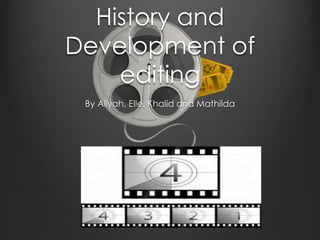
Presentation dues tuesday
- 1. History and Development of editing By Aliyah, Elle, Khalid and Mathilda
- 2. The purpose of editing Film editing is part of the creative post production process of filmmaking . Film editing is used to polish off film and make the clips flow together.
- 3. The very first film makers Nowadays we have modern technology which allow us to do simple editing, where as years ago the director had to make sure that they could film many clips from one scene. This was because the camera and its equipment was extremely heavy and their was quiet a long process of putting the camera together on its stand and start films with heavy rolls of tape. Because of the lack of technology in earlier years, to edit clips they would have had to cut out sections from the tape and place it on a new strip where they wanted the sequence to form.
- 4. The first individuals to experiment with editing. David LlewelynWark Griffith was a premier pioneering American film director. He is best known as the director of the epic 1915 film The Birth of a Nation. Griffith used camera and narrative techniques Eisenstinewas the first editor to use montage, he is famous for using it in ‘The Odessa Steps sequence’ This was a stylish way to make the audience feel like they was part of the action, this disorientates us and makes us feel confused because the cutting and editing was so fast, for example he used parallel editing and jump cutting. Battle ship clip: https://www.youtube.com/watch?feature=player_embedded&v=DLEE2UL_N7Q
- 5. The Kuleshov Effect is a montage effect demonstrated by Russian filmmaker Lev Kuleshov in the 1910s and 1920s. He edited together a short film in which a shot of the expressionless face ofIvan Mosjoukine was alternated with various other shots. The film was shown to an audience who believed that the expression on Mosjoukine's face was different each time he appeared, depending The man with the movie camera clip: https://vimeo.com/8082147
- 6. The different types of editing techniques and principles used today Starting this off, I would like to explain that the camera’s used in the olden days were big and heavy, therefore they used a lot of long shots mid shots because as I have said cameras were heavy and they did not really move the camera around. Nowadays we have digital camera were these type of new technology includes zooming in and out and that they are not heavy, therefore can be moved about. As camera are not heavy and can be moved about, different type of editing techniques were introduced, such as shot reversed shot.
- 7. Other type of editing is called parallel editing, this is a film technique of continuity editing that establishes the relationship between two subject by cutting from one to the other. One of the most important effects of the parallel edit is that of simultaneousness, suggesting that two events occur at the same time.
- 8. Montage Montage is a technique used in film editing in which a series of short shots are edited into a sequence that doesn’t need to flow but it condense space, time, and information. The shots or scenes are seemingly and unrelated and when combined they achieve meaning or seem quite similar. This techniques was famously used in a silent documentary film made in 1929 called ‘Man with a movie camera’ This is a loads of different shots of the film, this is the closes example I could show to a montage in the film
- 9. Jump cut Jump cut is one transition from one to clip to another, it’s a cut used in film editing in which two shots of the same subject are taken from camera positions that vary slightly. This type of edit makes the shots appear to "jump" position in a discontinuous way. Using a jump cut shot should provide continuity and have seamless flow.
- 10. The development of digital editing technology and technique In the early days of electronic video production, linear editing was the only way to edit videotapes. Linear editing is cutting pieces of the film and placing them where you want the edits to be cut and placed into the places they are required. If they editing went wrong, you would have to start all over again and redo what you have done wrong. Hard wear and soft wear are two different things, ccomputer hardware is any physical device, something that you are able to touch and software is a collection of instructions and code installed into the computer and cannot be touched.